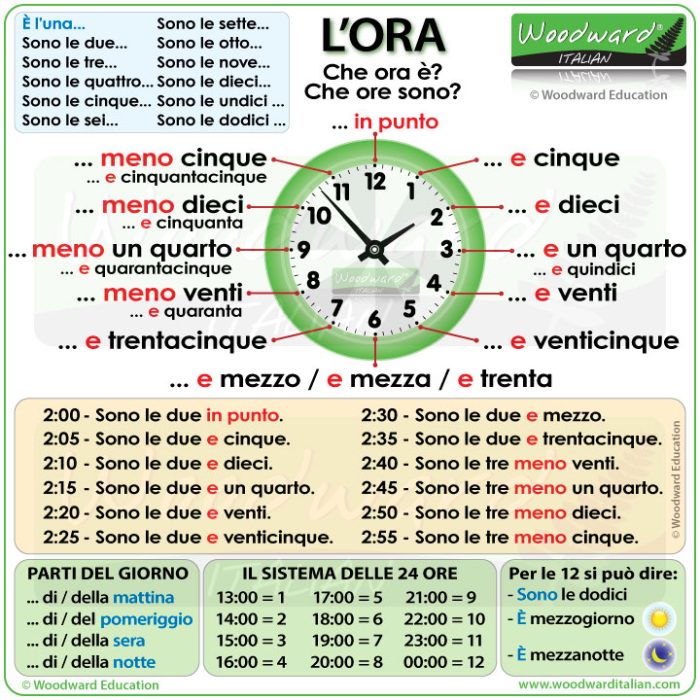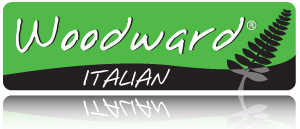How to tell the time in Italian
In Italian, you use the verb ESSERE to tell the time. You say:
- È l’una … (It’s one o’clock)
- Sono le due … (It’s two o’clock)
- Sono le tre … (It’s three o’clock)
- Sono le quattro … (It’s four o’clock)
- Sono le cinque … (It’s five o’clock)
- Sono le sei … (It’s six o’clock)
- Sono le sette. … (It’s seven o’clock)
- Sono le otto … (It’s eight o’clock)
- Sono le nove … (It’s nine o’clock)
- Sono le dieci … (It’s ten o’clock)
- Sono le undici … (It’s eleven o’clock)
- Sono le dodici … (It’s twelve o’clock)
As you can see, you use Sono le… most of the time as all the numbers are plural except for una (one).
The singular form of essere (è) is used in the following cases:
- È l’una. = It is one o’clock.
- È mezzogiorno. = It is midday / noon.
- È mezzanotte. = It is midnight.
Note: There is no article (le/la) before mezzogiorno or mezzanotte.
Adding minutes in Italian
- il minuto – the minute (singular)
- i minuti – the minutes (plural)
- l’ora – the hour (singular)
- le ore – the hours (plural)
After the hour, you use e and then the minutes: ora + e + minuti
- 1:10 – È l’una e dieci.
- 8:05 – Sono le otto e cinque.
- 7:20 – Sono le sette e venti.
- 5:25 – Sono le cinque e venticinque.
- 9:40 – Sono le nove e quaranta.
Yes, even for numbers larger from 31-59, you can use this way. (We will see another way of saying this in a moment)
15 y 30 minutos
When we talk about 15 minutes before or after the hour, you can use un quarto which means a quarter.
- 9:15 – Sono le nove e un quarto.
- 5:15 – Sono le cinque e un quarto.
- 5:45 – Sono le sei meno un quarto.
Though you still may hear e quindici used instead of e un quarto.
- 8:15 – Sono le otto e un quarto.
- 8:15 – Sono le otto e quindici.
When we talk about 30 minutes after the hour (i.e. half past X), you can use e mezzo or e mezza .
What is the difference between e mezzo and e mezza?
The version you hear depends on the region you are in. Both forms are accepted.
- 5:30 – Sono le cinque e mezzo.
- 5:30 – Sono le cinque e mezza.
- 3:30 – Sono le tre e mezzo.
Though you still may hear e trenta used instead of e mezzo / e mezza.
- 8:30 – Sono le otto e mezzo.
- 8:30 – Sono le otto e trenta.
Using MENO to tell the time in Italian
As we have already seen, we can add E before the minutes. However, another way to say the time when the minutes are 41 to 59, is to use meno which literally means less. MENO is like TO in English in that we count the minutes remaining before we reach the top of the hour.
- 8:50 = Sono le nove meno dieci. – It’s ten to nine.
Did you see the word order in Italian? The closest hour (in this case 9) comes first.
- Sono le nove meno dieci … literally means nine less ten (minutes)
It’s like how in English you say: ten TO nine. Just the order in Italian is different.
That is because it is like saying 9 (nove) less (meno) 10 (dieci).
Of course, you may also hear:
- 8:50 = Sono le otto e cinquanta.
For X:35 (thirty-five minutes after the hour), it is not common to say/hear meno venticinque. E trentacinque is the usual form.
When we talk about 45 minutes after the hour, you may sometimes hear e tre quarti which means and three quarters.
- 9:45 – Sono le nove e quarantacinque.
- 9:45 – Sono le nove e e tre quarti.
- 9:45 – Sono le dieci meno un quarto.
Mattina / pomeriggio / sera / notte
We can also add a time period at the end for clarification:
- di mattina (in the morning) – della mattina
- di pomeriggio (in the afternoon) … or … del pomeriggio.
- di sera (in the evening) – della sera
- di notte (at night) – della notte (usually used after midnight)
You may hear / read del pomeriggio instead of di pomeriggio for in the afternoon.
You may also hear della mattina, della sera and della notte used. They are for specific occasions. We will learn more about the use of these later.
Here are a couple of example sentences:
- Sono le otto di mattina.
It is 8 in the morning. - Sono le dieci di sera.
It is 10 in the evening.
Examples of the time in Italian
- 3:00 – Sono le tre.
- 4:05 – Sono le quattro e cinque.
- 5:10 – Sono le cinque e dieci.
- 8:10 – Sono le otto e dieci.
- 8:15 – Sono le otto e un quarto.
- 7:15 – Sono le sette e un quarto.
- 6:30 – Sono le sei e mezzo.
- 8:30 – Sono le otto e mezzo.
- 4:30 – Sono le quattro e mezzo.
- 5:35 – Sono le cinque e trentacinque.
- 7:40 – Sono le otto meno venti.
- 9:40 – Sono le dieci meno venti.
- 8:45 – Sono le nove meno un quarto.
- 9:50 – Sono le dieci meno dieci.
How to ask for the time in Italian – Question
There are two ways of asking for the time in Italian:
- Che ora è?
- Che ore sono?
Both are correct. Notice how with Che ore sono? you are using both the noun and verb in their plural form.
Literally you are asking: What hour is it? or What hours are they?
If you are going to ask the time from a stranger or on the street, a polite way of asking is:
- (Mi) scusi, mi può dire l’ora per favore? (= Excuse me, can you tell me the time please?)
A che ora? – At what time?
When you want to ask the exact time of a specific event, you can ask: A che ora…?
The answer normally contains: Alle (+ time)
- Alle due = At two.
- Alle otto = At eight.
- Alle nove e un quarto = At quarter past nine.
The exception is before una when it becomes: All’una.
- A: A che ora inizia la lezione di italiano? B: Alle undici e mezzo.
A: What time does the Italian lesson begin? B: At 11.30. - A: A che ora è l’appuntamento? B: Alle dieci e un quarto.
A: What time is the appointment? B: At 10.15. - A: A che ora inizia la partita? B: All’una.
A: What time does the game begin? B: At 1.
If you use mezzogiorno / mezzanotte, then you use use “a” before them:
a mezzogiorno – a mezzanotte
- A: A che ora inizia la partita? B:A mezzogiorno
- A: What time does the game begin? B: At midday.
In punto / precise
Sometimes in punto or precise are used to state the time is exactly on the hour without any minutes (e.g. 7:00).
In punto means on the dot.
Precise means exactly or precisely.
- È l’una in punto. = It is one o’clock on the dot.
- Sono le sette in punto. = It is seven o’clock on the dot.
- È l’una precisa. = It is exactly one o’clock.
- Sono le sette precise. = It is exactly seven o’clock.
Notice how precisa is used with UNA (one) because it is singular. We use precise for the rest of the hours because they are plural.
The 24-hour clock in Italy
In Italian it is common to use the 24-hour clock (sistema delle 24 ore). We will learn more about how to tell the time using the 24-hour clock in our next lesson.
More examples of time in Italian
Here are more examples of the time in Italian using the different ways we have learned of saying the time every 5 minutes from 2 o’clock to 3 o’clock
- 2:00 – Sono le due in punto.
- 2:05 – Sono le due e cinque.
- 2:10 – Sono le due e dieci.
- 2:15 – Sono le due e un quarto.
2:15 – Sono le due e quindici. - 2:20 – Sono le due e venti.
- 2:25 – Sono le due e venticinque.
- 2:30 – Sono le due e mezzo.
2:30 – Sono le due e mezza.
2:30 – Sono le due e trenta. - 2:35 – Sono le due e trentacinque.
- 2:40 – Sono le due e quaranta.
2:40 – Sono le tre meno venti. - 2:45 – Sono le due e quarantacinque.
2:45 – Sono le tre meno un quarto.
2:45 – Sono le due e tre quarti. - 2:50 – Sono le due e cinquanta.
2:50 – Sono le tre meno dieci. - 2:55 – Sono le due e cinquantacinque.
2:55 – Sono le tre meno cinque. - 3:00 – Sono le tre.
Telling the time in Italian – Summary Chart

Che ore sono nel tuo paese ora?
What time is it in your country now?
I hope you found this lesson about Come dire l’orario in italiano (How to tell the time in Italian) useful.
If you did, please let other people know about Woodward Italian.
